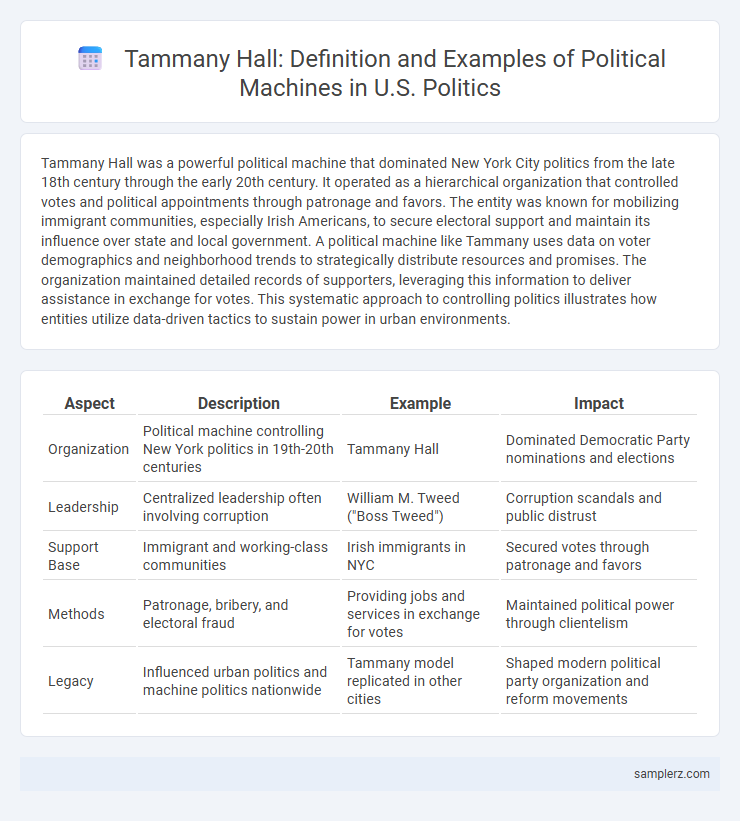Tammany Hall was a powerful political machine that dominated New York City politics from the late 18th century through the early 20th century. It operated as a hierarchical organization that controlled votes and political appointments through patronage and favors. The entity was known for mobilizing immigrant communities, especially Irish Americans, to secure electoral support and maintain its influence over state and local government. A political machine like Tammany uses data on voter demographics and neighborhood trends to strategically distribute resources and promises. The organization maintained detailed records of supporters, leveraging this information to deliver assistance in exchange for votes. This systematic approach to controlling politics illustrates how entities utilize data-driven tactics to sustain power in urban environments.
Table of Comparison
| Aspect | Description | Example | Impact |
|---|---|---|---|
| Organization | Political machine controlling New York politics in 19th-20th centuries | Tammany Hall | Dominated Democratic Party nominations and elections |
| Leadership | Centralized leadership often involving corruption | William M. Tweed ("Boss Tweed") | Corruption scandals and public distrust |
| Support Base | Immigrant and working-class communities | Irish immigrants in NYC | Secured votes through patronage and favors |
| Methods | Patronage, bribery, and electoral fraud | Providing jobs and services in exchange for votes | Maintained political power through clientelism |
| Legacy | Influenced urban politics and machine politics nationwide | Tammany model replicated in other cities | Shaped modern political party organization and reform movements |
The Rise of Tammany Hall: Foundations of a Political Machine
Tammany Hall emerged as a powerful political machine in 19th-century New York City, leveraging immigrant votes and patronage to consolidate control over local government. Its rise was fueled by strategic alliances with ethnic communities, particularly Irish immigrants, who received social services and jobs in exchange for political loyalty. The organizational structure of Tammany Hall set a precedent for urban political machines by combining grassroots mobilization with centralized authority.
Key Leaders of Tammany: Boss Tweed and Beyond
Boss Tweed, the most notorious leader of Tammany Hall, orchestrated widespread political corruption in 19th-century New York City, using patronage and graft to consolidate power. Following Tweed's downfall, figures like Richard Croker and Charles F. Murphy exemplified the machine's adaptability, maintaining influence through electoral manipulation and alliances with business interests. The legacy of key leaders highlights Tammany's evolution as a durable political organization that shaped urban governance and Democratic Party politics.
Methods of Influence: Patronage and Voter Mobilization
Tammany Hall exemplified political influence through systematic patronage, distributing government jobs and social services to loyal supporters to secure votes and maintain control in New York City. Its voter mobilization tactics involved organized election-day efforts, ensuring high turnout among immigrant and working-class communities by providing transportation and incentives. This combination of patronage and grassroots mobilization enabled Tammany to dominate local politics throughout the 19th and early 20th centuries.
Tammany’s Impact on Urban Governance
Tammany Hall shaped urban governance by centralizing political power and orchestrating patronage networks that influenced public policy and municipal administration in New York City for over a century. Its control over city contracts, jobs, and services entrenched machine politics, affecting electoral outcomes and public resource allocation. This political dominance highlighted the complexities and challenges of urban governance reform in rapidly growing American cities.
Corruption and Scandal: Notorious Tammany Examples
Tammany Hall, a powerful political machine in New York City, became synonymous with corruption through scandals like the Tweed Ring, where Boss William M. Tweed exploited municipal funds, siphoning millions from taxpayers. The manipulation of city contracts and voter intimidation tactics underscored the pervasive corruption that allowed Tammany leaders to maintain control over democratic processes. These notorious examples highlight systemic graft and the challenges of political reform in urban governance.
Social Services as Strategy: Charity and Control
Tammany Hall utilized social services as a strategic tool, blending charity with political control to maintain voter loyalty and influence. By providing essential aid such as food, housing, and medical care, Tammany secured the support of immigrant and low-income communities while reinforcing its patronage system. This dual approach underscored how social welfare initiatives could function as mechanisms of political power and social regulation.
Ethnic Communities and Tammany’s Inclusive Tactics
Tammany Hall strategically incorporated ethnic communities, particularly Irish immigrants, by offering social services, jobs, and political representation, fostering loyalty and political support. This inclusive approach extended to diverse immigrant groups through patronage and localized outreach, embedding Tammany deeply within urban political machine dynamics. Such tactics enabled Tammany to consolidate power and maintain control over city governance by leveraging ethnic solidarity and addressing community-specific needs.
Reform Movements Against Tammany Power
Reform movements against Tammany Hall targeted its entrenched political corruption and patronage system, aiming to dismantle the powerful Democratic machine in New York City during the late 19th and early 20th centuries. Key figures such as Samuel J. Tilden and Theodore Roosevelt championed civil service reforms and transparency initiatives to curtail Tammany's control over municipal appointments and elections. These efforts culminated in landmark legislation and investigative journalism campaigns that exposed graft and promoted accountability in urban governance.
Legacy of Tammany: Shaping Modern Political Machines
Tammany Hall exemplifies the archetype of a political machine, embedding patronage and grassroots mobilization into urban politics that influenced modern governance structures. Its legacy persists in the continued use of organized political networks to secure voter loyalty and control local governments. The Tammany model highlights the blend of populism and corruption that shaped the dynamics of political power in American cities.
Lessons from Tammany for Today’s Politics
Tammany Hall exemplifies how political machines use patronage and voter manipulation to consolidate power, offering critical lessons for today's politics on the dangers of corruption and unchecked influence. Modern political organizations can learn the importance of transparency, accountability, and reform to prevent the erosion of democratic processes seen in Tammany's era. Emphasizing civic engagement and robust oversight helps guard against the resurgence of machine-style control in contemporary governance.

example of Tammany in machine Infographic
 samplerz.com
samplerz.com